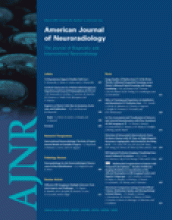Abstract
BACKGROUND AND PURPOSE: The purpose of this study was to assess the incidence of de novo aneurysm formation, the incidence of subarachnoid hemorrhage (SAH), and the growth of existing untreated aneurysms in 52 patients after therapeutic carotid artery balloon occlusion for carotid aneurysms.
PATIENTS AND METHODS: Between January 1996 and August 2004, 52 patients were treated with carotid artery balloon occlusion for carotid aneurysms. In June 2005, all patients, their next of kin, or family physicians were contacted and questioned concerning episodes of headache or hospital admissions that could be attributed to SAH. In addition, MR imaging and MR angiography (MRA) at 3T were performed in 26 of 44 surviving patients after a mean follow-up period of 50.2 months (median, 43.5 months; range, 14–107 months). MR imaging and MRA studies were compared with the digital subtraction angiograms at the time of carotid artery occlusion.
RESULTS: During clinical follow-up of 52 patients at a mean of 50.3 months (median, 42.5 months; range, 0–107 months), no episodes of SAH were reported (0%; 97.5% confidence interval [CI], 0–8.2%). In the 26 patients with follow-up MR imaging, no de novo aneurysms were detected (0%; 97.5 CI, 0–13.2%). Five existing untreated small aneurysms in 5 patients had not enlarged after a mean follow-up of 40 months.
CONCLUSION: In this study, therapeutic carotid artery occlusion was not associated with development of new aneurysms or enlargement of existing untreated aneurysms with time.
- Copyright © American Society of Neuroradiology












